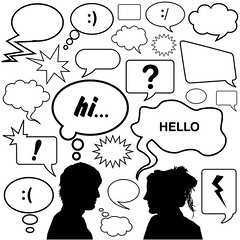
A good way to draw your reader deeply into your story is to use a variety of non-verbal cues in your dialogue. Try the following techniques to dial up your dialogue.
Facial Expressions
When a character raises an eyebrow or furrows his brow, this action gives the reader an additional clue beyond dialogue that indicates a change in the character’s emotional state. As the scene progresses and the emotional intensity rises; the character’s dissatisfaction grows into anger, for instance, the character might clamp his jaw, his nostrils may flare, or eyes narrow to a squint, his face may redden and so on. These are all commonly understood signs of anger.
To learn effective use of these cues, read classic works containing emotional encounters or watch good dramatic films with the sound turned off. Study the facial expressions of the actors and take notes of how they signal emotion. Continue reading “Dialing Up Your Dialogue”